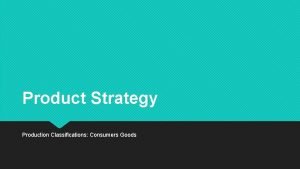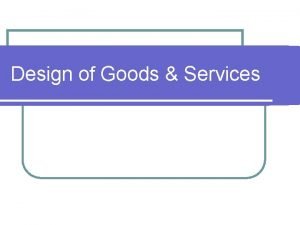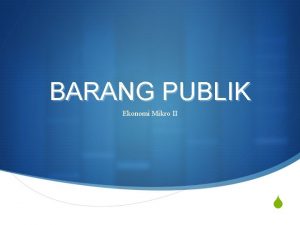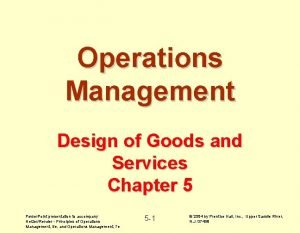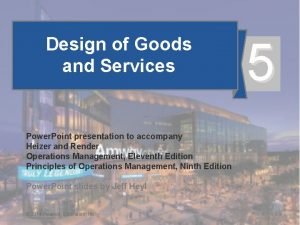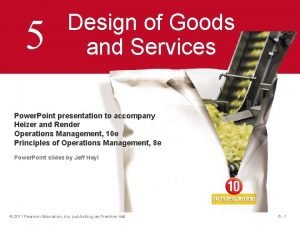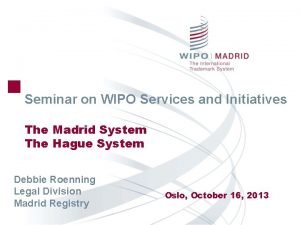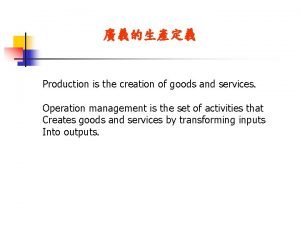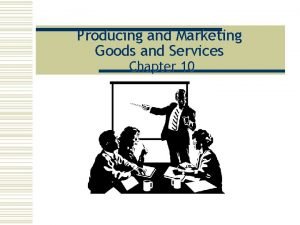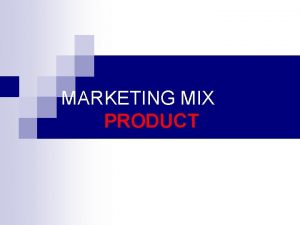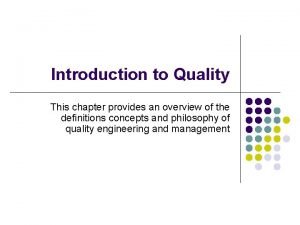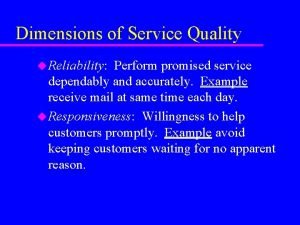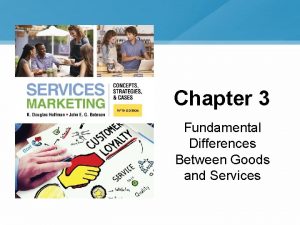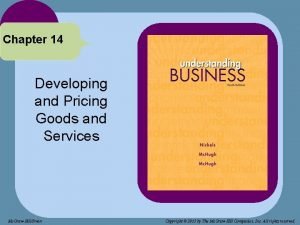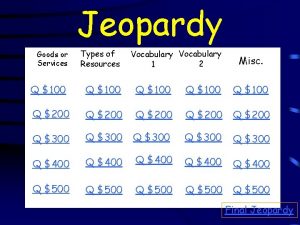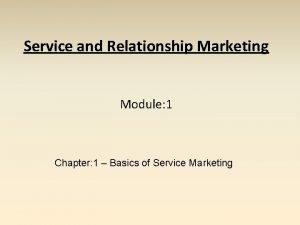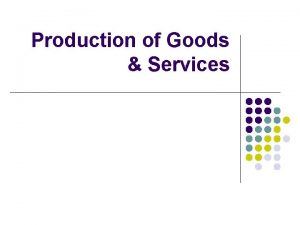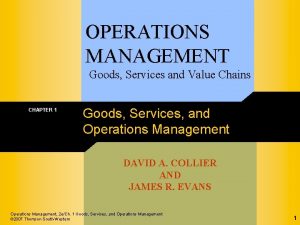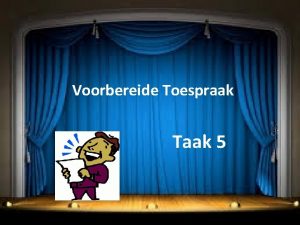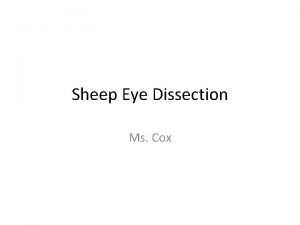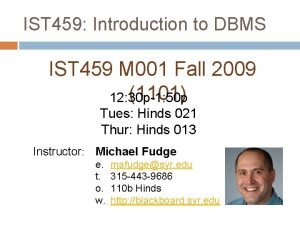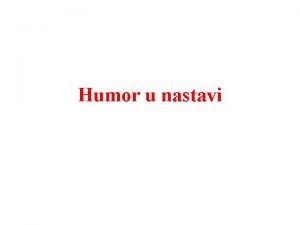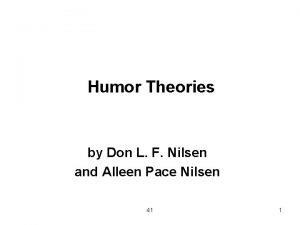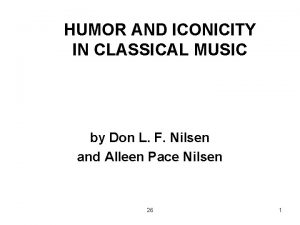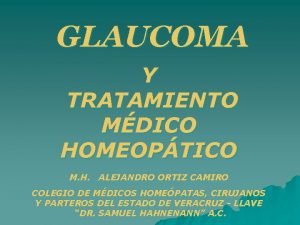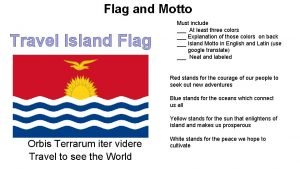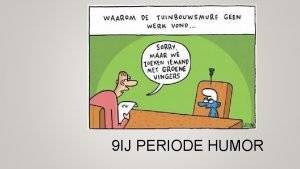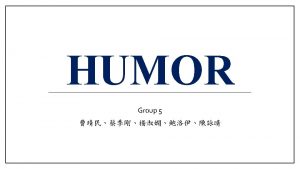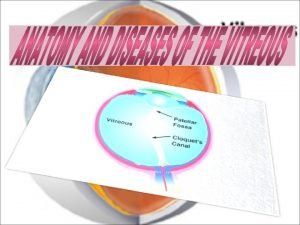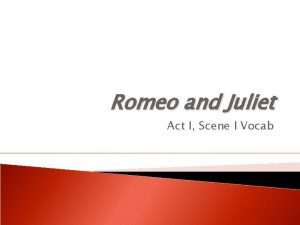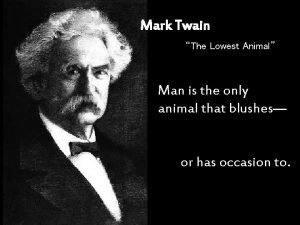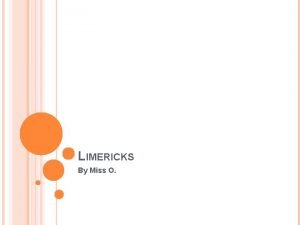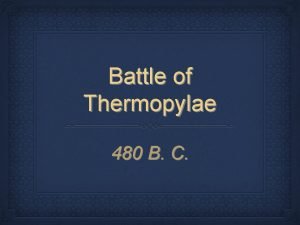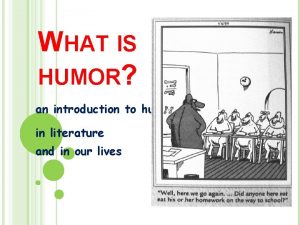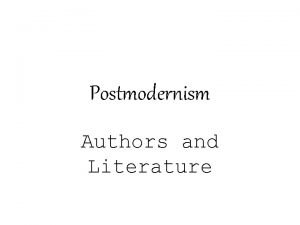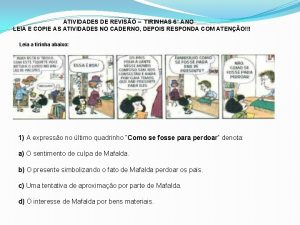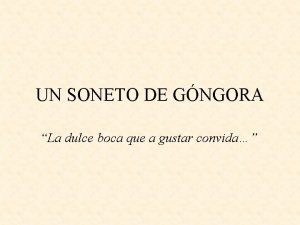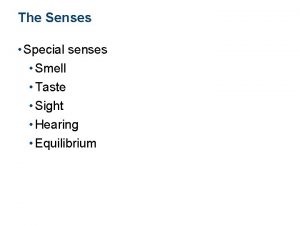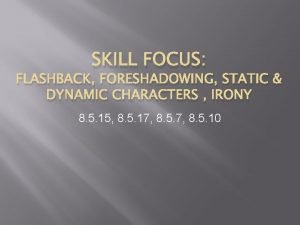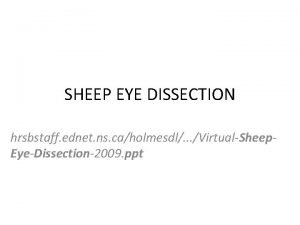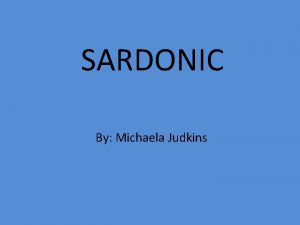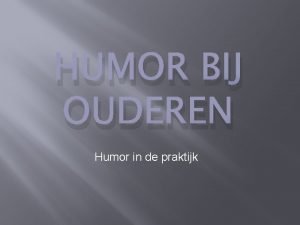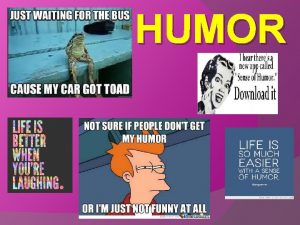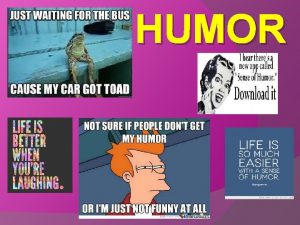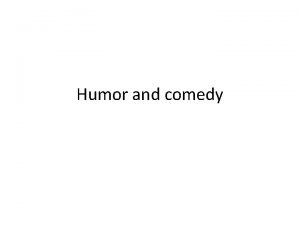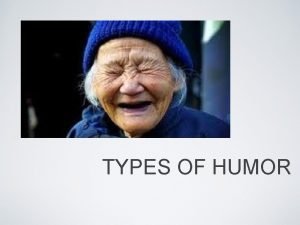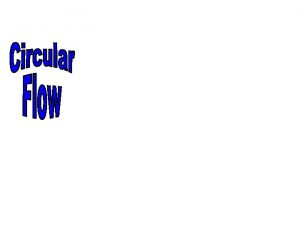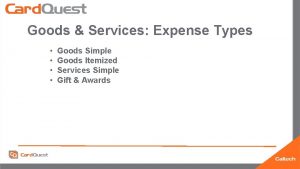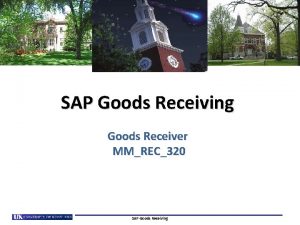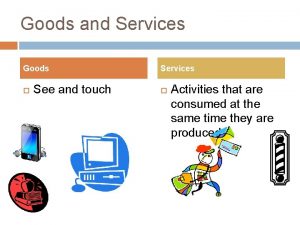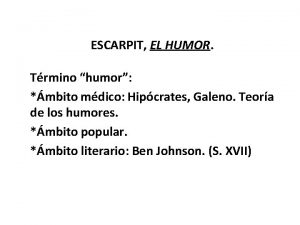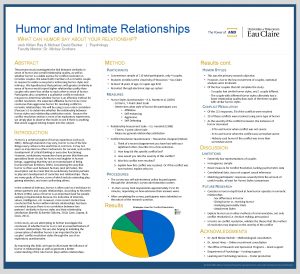Design of Goods Services Humor in Product Design



































































- Slides: 67

Design of Goods & Services

Humor in Product Design

What is a Product? l Need-satisfying offering of an organization l Example l P&G does not sell laundry detergent l P&G sells the benefit of clean clothes l Customers buy satisfaction, not parts l May be a good or a service

Generation of New Product Opportunities l Economic change l Sociological and demographic change l Technological change l Political/legal change l Changes in l market practice l professional standards l suppliers and distributors

Product Components Product Brand (Name) Physical Good Product Idea Features Quality Level Package Service (Warranty)

Product Life Cycle l Introduction l Growth l Maturity l Decline

Product Life Cycle Introduction l Fine tuning l research l product development l process modification and enhancement l supplier development

Product Life Cycle Growth l Product design begins to stabilize l Effective forecasting of capacity becomes necessary l Adding or enhancing capacity may be necessary

Product Life Cycle Maturity l Competitors now established l High volume, innovative production may be needed l Improved cost control, reduction in options, paring down of product line

Product Life Cycle Decline l Unless product makes a special contribution, must plan to terminate offering

Sales, Cost & Profit Product Life Cycle vs. Sales, Cost, and Profit Cost of Development & Manufacture Sales Revenue Profit Loss Cash flow Time Introduction Growth Maturity Decline

Percent of Sales From New Product

Products in Various Stages of Life Cycle Sales Introductio n Growth Plasma TVs Maturity Decline Cell Phones VCRs Hybrid Cars Time

Number 2000 1500 1000 500 0 Ideas 1750 Few Successes Design review, Market Testing, Introduction requiremen t 1000 Functional specification Product s 500 specificatio One n 100 25 succes s! Development Stage

Product-by-Value Analysis l Lists products in descending order of their individual dollar contribution to the firm. l Helps management evaluate alternative strategies.

Scope of product development team Product Development Stages l Idea generation l Assessment of firm’s ability to carry out l Customer Requirements l Functional Specification l Product Specifications l Design Review l Test Market l Introduction to Market l Evaluation Scope of design for manufacturabilit y and value engineering teams

Quality Function Deployment l Identify customer wants l Identify how the good/service will satisfy customer wants l Relate customer wants to product hows l Identify relationships between the firm’s hows l Develop importance ratings l Evaluate competing products

QFD House of Quality

House of Quality Sequence

Idea Generation Stage l Provides basis for entry into market l Sources of ideas l Market need (60 -80%); engineering & operations (20%); technology; competitors; inventions; employees l Follows from marketing strategy l Identifies, defines, & selects best market opportunities

Customer Requirements Stage l Identifies & positions key product benefits l Stated in core benefits proposition (CBP) l Identifies detailed list of product attributes desired by customer l Focus groups or 1 -on-1 interviews

Functional Specification Stage l Defines product in terms of how the product would meet desired attributes l Identifies product’s engineering characteristics l Example: printer noise (d. B) l Prioritizes engineering characteristics l May rate product compared to competitors’

Product Specification Stage l Determines how product will be made l Gives product’s physical specifications l Example: Dimensions, material etc. l Defined by engineering drawing l Done often on computer Computer- Aided Design (CAD)

Quality Function Deployment l Product design process using cross-functional teams l Marketing, engineering, manufacturing l Translates customer preferences into specific product characteristics l Involves creating 4 tabular ‘Matrices’ or ‘Houses’ l Breakdown product design into increasing levels of detail

House of Quality Example You’ve been assigned temporarily to a QFD team. The goal of the team is to develop a new camera design. Build a House of Quality. © 1984 -1994 T/Maker Co.

House of Quality Example Customer Requirements Importance Target Values High relationship� Medium relationship Low Relationsh

House of Quality Example What the customer desires (‘wall’) Customer Requirements Importance Aluminum Parts Auto Focus Auto Exposure Light weight Easy to use Reliable Target Values High relationship � Medium relationship Low Relationship

House of Quality Example Average customer importance rating Customer Requirements Importance Light weight Easy to use Reliable Aluminum Parts Auto Focus Auto Exposure 3 2 1 Target Values High relationship� Medium relationship Low Relationship

House of Quality Example Relationship between customer attributes & engineering characteristics (‘rooms’) Customer Requirements Importance Light weight Easy to use Reliable 3 2 1 Aluminum Parts Auto Focus Auto Exposure High relationship � Medium relationship Low Relationship

House of Quality Example Target values for engineering characteristics (‘basement’); key output Customer Requirements Importance Light weight Easy to use Reliable Target Values 3 2 1 Aluminum Parts 5 Auto Focus Auto Exposure 1 1 High relationship � Medium relationship Low Relationship

Organizing for Product Development l Historically – distinct departments l Duties and responsibilities are defined l Difficult to foster forward thinking l Today – team approach l Representatives from all disciplines or functions l Concurrent engineering – cross functional teams including research, development, manufacturing process design, etc.

Manufacturability and Value Engineering l Benefits: l reduced complexity of products l additional standardization of products l improved functional aspects of product l improved job design and job safety l improved maintainability of the product l robust design

Cost Reduction of a Bracket via Value Engineering

Successful Value Engineering: l l l Support of top management Qualified, experience leadership Formal organization of the value engineering function Training programs to teach the skills and techniques to those assigned to teams A diverse, cooperating team Adequate staffing, funding, and vendor assistance

Issues for Product Development l Robust design l Time-based competition l Modular design l Computer-aided design l Value analysis l Environmentally friendly design l “Green” manufacturing

Robust Design l Products are designed so that they may be manufactured uniformly and consistently despite adverse manufacturing and environmental conditions.

Time-based Competition l Product life cycles are becoming shorter. Faster developers of new products gain on slower developers and obtain a competitive advantage

Modular Design l Products designed in easily segmented components known as modular designs l Adds flexibility to both production and marketing l Examples: l Airbus – wings l Fast food – buns, vegetables, etc. l Dell computer

Computer Aided Design (CAD) l Designing products at a computer terminal or work station l l l Design engineer develops rough sketch of product Uses computer to draw product Often used with CAM © 1995 Corel Corp.

CAD & CAM l Benefits of CAD l l l Shorter design time Database availability New capabilities Improved product quality Reduced production costs l Extensions l l l Design for Manufacturing and Assembly (DFMA) 3 -D Object Modeling CAD info is translated into machine control instructions (CAM)

Virtual Reality l Computer technology used to develop an interactive, 3 -D model of a product l Especially helpful in design of layouts (e. g. factory, store, home, office, etc. )

Value Analysis l Focuses on design improvement during production l Seeks improvements leading either to a better product or a product which can be more economically produced

Environmentally Friendly Designs l Benefits l Safe and environmentally sound products l Minimum raw material and energy waste l Product differentiation l Environmental liability reduction l Cost-effective compliance with environmental regulations l Recognition as good corporate citizen

“Green” Manufacturing l Make products recyclable l Use recycled materials l Use less harmful ingredients l Use lighter components l Use less energy l Use less material

Product Development Continuum External Development Strategies Alliances Joint Ventures Purchase Technology or Expertise by Acquiring the Developer Internal Development Strategies Migrations of Existing Products Enhancement to Existing Products New Internally Developed Products Internal -----------Cost of Product Development ------------- Shared Lengthy ----------Speed of Product Development----- Rapid and/or Existing High ------------- Risk of Product Development -------------- Shared

Product Documents l Engineering drawing Shows dimensions, tolerances, & materials l Shows codes for Group Technology l Bill of Material l Lists components, quantities & where used l Shows product structure l l Engineering Change Notice (ECN) l A correction or modification of an engineering drawing or bill of material

Monterey Jack (a) U. S. grade AA. Monterey cheese shall conform to the following requirements: (1)Flavor - Is fine and highly pleasing, free from undesirable flavors and odors. May possess a very slight acid or feed flavor. (2)Body and texture - A plug drawn from the cheese shall be reasonably firm. It shall have numerous small mechanical openings evenly distributed throughout the plug. It shall not possess sweet holes, yeast holes, or other gas holes (3)Color - Shall have a natural, uniform, bright and attractive appearance. (4)Finish and appearance - bandaged and paraffin-dipped. The rind shall be sound, firm, and smooth providing a good protection to the cheese Code of Federal Regulation, Parts 53 to 109, . Revised as of Jan. 1, 1985, General Service Administration

Engineering Drawing Example

Engineering Drawings - Show Dimensions, Tolerances, etc.

Bill of Material Example

BOM – Manufacturing vs. Fast -Food Bill of Material for a Panel Weldment Number A 60 -71 A 60 -7 R 60 -17 R 60 -428 P 60 -2 60 -72 R 60 -57 -1 A 60 -4 02 -501150 A 60 -73 A 60 -74 R 60 -99 02 -501150 Hard Rock Café’s Hickory BBQ Bacon Cheeseburger Description Qt y Description Qty Panel Weldm’t 1 Bun Hamburger Patty Cheddar Cheese Bacon BBQ Onions Hickory BBQ Sauce Burger Set Lettuce Tomato Red Onion Pickle French Fries Seasoned Salt 11 -inch Plate HRC Flag 1 8 oz. 2 slices 2 strips ½ cup 1 oz. 1 leaf 1 slice 4 rings 1 slice 5 oz. 1 tsp 1 1 Lower Roller Assembly Roller Pin Locknet Guide Assem. Rear 1 1 Support Angle Roller Assem. Bolt 1 1 Guide Assm, Front Support Weldm’t Wear Plate Bolt 1 1

Make-or-Buy Decisions l Decide whether or not you want (or need) to produce an item l May be able to purchase the item as a “standard item” from another manufacturer

Reasons for Making l l l lower production cost unsuitable suppliers assure adequate supply utilize surplus labor and make a marginal contribution obtain desired quality remove supplier collusion obtain a unique item that would entail a prohibitive commitment from the supplier l maintain organizational talent l protect proprietary design or quality l increase/maintain size of company l

Reasons for Buying l l lower acquisition cost preserve supplier commitment obtain technical or management ability inadequate capacity reduce inventory costs ensure flexibility and alternate source of supply l reciprocity l item is protected by patent or trade secret l frees management to deal with its primary business l

Group Technology Characteristics l Parts grouped into families l Similar, more standardized parts l Uses coding system l Describes processing & physical characteristics l Part families produced in manufacturing cells l Mini-assembly lines

Group Technology Code Example 4 mm x 45° chamfer 80 mm 60 mm Round Rod Product Code: 1 5 3 1 112 mm Part function (round rod) Material (steel) Max. length (50 < L < 150) Primary machine (lathe)

Group Technology Schemes Enable Grouping of Parts

Group Technology Benefits l Improved product design l Reduced purchases l Reduced work-in-process inventory l Improved routing & machine loading l Reduced setup & production times l Simplified production planning & control l Simplified maintenance

Production Documents l Assembly Drawing l Assembly chart l Route sheet l Work order

Assembly Drawing Shows exploded view of product Head Neck Handle End Cap

Assembly Drawing and Chart

Route Sheet Lists all operations

Work Order Authorizes producing a given item, usually to a schedule g r Order n. Wo i r u t c a f u Man Dakte r e p O t ep D : ed v o r p Ap JM

Configuration Management l A system by which a product’s planned and changing components are accurately identified and for which control and accountability of change are maintained

Service Design – Customer Participation

Decision Trees & Product Design l Particularly useful when there a series of decisions and outcomes which lead to other decisions and outcomes. l Considerations: Include all possible alternatives and states of nature - including “doing nothing” l Enter payoffs at end of each branch l Approach determining expected values by backward induction & “pruning” tree l

Transition to Production First issue: knowing when to move to production l Second issue: must view product development as evolutionary, not the responsibility of single individual or department l Third issue: expect to need a trial production period to work the bugs out l Fourth issue: recognize that responsibility must also transition l
 Consumer products classifications
Consumer products classifications Humor
Humor Type of product
Type of product Progressive tax examples
Progressive tax examples Positive consumption externality
Positive consumption externality Publik goods
Publik goods Design of goods and services in operations management
Design of goods and services in operations management Design of goods and services
Design of goods and services Design of goods and services
Design of goods and services Wipo romarin madrid monitor
Wipo romarin madrid monitor Sale of goods and supply of services act 1980
Sale of goods and supply of services act 1980 Production is a creation of
Production is a creation of Marketing goods and services
Marketing goods and services Elements of product mix
Elements of product mix Quality dimensions of goods and services
Quality dimensions of goods and services Quality dimensions of goods and services
Quality dimensions of goods and services Difference between goods and services
Difference between goods and services Goods and services exempted from vat in rwanda
Goods and services exempted from vat in rwanda Total product offer
Total product offer A form for recording transactions in chronological order
A form for recording transactions in chronological order Goods and services vocabulary
Goods and services vocabulary Means acquiring goods and or services
Means acquiring goods and or services Goods and services examples
Goods and services examples Production of goods and services
Production of goods and services Owned goods examples
Owned goods examples A form for recording transactions in chronological order
A form for recording transactions in chronological order System design in operations management
System design in operations management Toespraak onderwerpe
Toespraak onderwerpe Mr bean non verbal communication
Mr bean non verbal communication Suspensory ligaments cow eye
Suspensory ligaments cow eye Database humor
Database humor Humor device
Humor device Humor u nastavi
Humor u nastavi Humor
Humor Humor in classical music
Humor in classical music Observational comedy
Observational comedy Glaucoma angulo abierto vs cerrado
Glaucoma angulo abierto vs cerrado Symbols that represent humor
Symbols that represent humor Dry sense of humor
Dry sense of humor Humour in waiting for godot
Humour in waiting for godot Kolder humor
Kolder humor Different types of humor
Different types of humor Humor column example
Humor column example Vitreous humor composition
Vitreous humor composition Satire in huck finn
Satire in huck finn Valiant romeo and juliet
Valiant romeo and juliet Hyperbole in the lowest animal
Hyperbole in the lowest animal A humorous rhyming 5 line poem
A humorous rhyming 5 line poem Irony dialogue
Irony dialogue Form of intelligent humor
Form of intelligent humor Sophomoric humor meaning
Sophomoric humor meaning Thermopylae a soldier's humor
Thermopylae a soldier's humor What is humor
What is humor Postmodern literature
Postmodern literature Big exaggeration, usually with humor
Big exaggeration, usually with humor Playwright vs playwrite
Playwright vs playwrite Bem voce conseguiu ferir meus sentimentos
Bem voce conseguiu ferir meus sentimentos La dulce boca
La dulce boca Aqueous humor
Aqueous humor Dynamic irony
Dynamic irony Sheep eye retina
Sheep eye retina Comic situations examples
Comic situations examples Sardonic
Sardonic Hard werken humor
Hard werken humor Humor docente
Humor docente Un humor entre perlas destilado
Un humor entre perlas destilado Ouderen humor
Ouderen humor La vida es tan corta
La vida es tan corta
